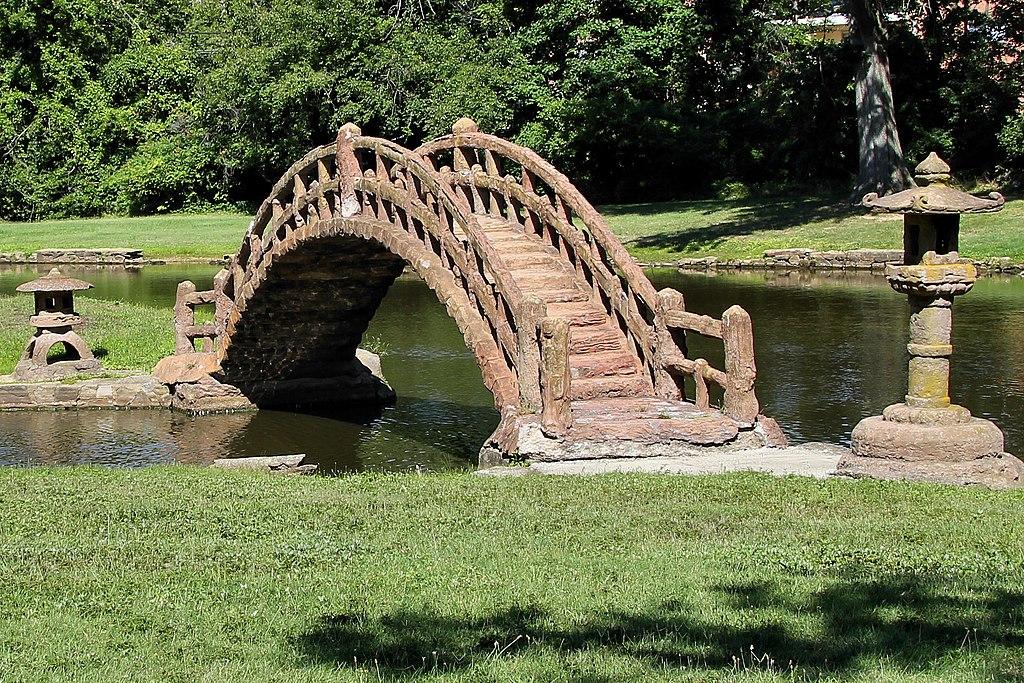Nestled within the rolling landscape of Cedar Hill Cemetery in Suitland, Maryland, lives a haunting reminder of the lives it holds. At first glance, The Bridge of Life looks like a twisted wooden foot bridge; in reality, it is the work of famed artist Dionicio Rodriguez, an early 20th-century Mexican sculptor who used the faux bois technique to transform reinforced concrete to look like ancient wood, down to intricate insect burrows and peeling bark. The Bridge of Life is one of seven works by Rodriguez in the cemetery, all constructed in the 1930s; they are thought to be the only examples of his work on the East Coast.
Today, Rodriguez’s sculptures are considered endangered, according to a comprehensive history and conditions assessment of Cedar Hill Cemetery by University of Maryland (UMD) students, part of a semester-long project commissioned by the Prince George’s County Planning Department. The report was one of eight projects presented to Prince George’s County agencies this past week as part of UMD’s Partnership for Action Learning in Sustainability (PALS) program.
Developed by UMD’s National Center for Smart Growth, PALS pairs faculty expertise and student ingenuity with sustainability challenges facing Maryland communities. The PALS mission is to provide high quality, low-cost assistance to local governments while creating an active and valuable real-world learning experience for UMD students. Launched in 2014 as a partnership with The City of Frederick, Maryland, PALS has since collaborated with 20 Individual communities, counties or departments, ranging from community partnership groups and cities to county and state agencies. The program has engaged nearly 2,300 students and faculty to improve quality of life in Maryland through site-specific projects.
Graduate students Hannah Cameron, Frankie Evans and Devon Murtha noted the rich history of Cedar Hill, which, in addition to Rodriguez’ sculptures, includes mausoleums dating back to the early 1900s, mature trees and landscape features and a mass grave for victims of the Terra Cotta Railroad wreck that occurred near Washington, D.C., in 1906. Cedar Hill is also the final resting place of famous athletes, supreme court justices and several congressmen. A comprehensive history of Cedar Hill’s historic resources and an appraisal of their integrity led to several recommendations for both preservation and community engagement as well as a Maryland Inventory of Historic Properties nomination form to help the county in protection and restoration efforts.
“I’m so excited to see this,” said Adele Gravitz, senior planner for Prince George’s County Department of Planning. “People understand the importance of architecture, but they don’t always understand the landscapes or the stories behind them.”
The projects conducted this past fall are part of an ongoing partnership with Prince George’s County, encompassing county priorities such as greenhouse gas emissions, food access, citizen health and recreation, economic development and preservation. A few of this year’s projects also tackled issues the county has faced due to COVID-19, including meal distribution to children and families and senior access to recreation activities.
An assessment of the Langley Park/Adelphi area by historic preservation students Winnie Cargill and Joseph Tannir resulted in a story map of around 50 cultural resources that tells the area’s immigrant story—from its early 20th century German and Polish inhabitants to the diverse Latin American population that lives there today. Sites range from mansions, private residences and farmhouses to the home of activist Mary Harris “Mother” Jones, Adelphi’s iconic cool spring houses and the first Kung Fu school in D.C.
“The students did a great job with this project,” says Prince George’s Planning Coordinator Tom Gross (M.H.P., M.C.P ‘16). “A challenge for us was identifying the diverse and extensive history in this area of the county and they have succeeded in bringing a lot of these great sites to our attention.”
In another project, a plant sciences course devised a hydroponic/aquaponic system that transforms empty industrial and commercial spaces into sites for urban agriculture. Two undergraduate classes in applied agriculture and plant sciences created a comprehensive plan for a farmer’s market in Brandywine, which included a site analysis, survey of area farms, funding opportunities and organizational and marketing strategies. Graduate students from the iSchool leveraged user-centered design research methods, which emphasize the lived experience of users, to find gaps and opportunities in the county’s senior ID access card program. The students created new pathways for seniors to “lean in” to technology, a necessity in the time of COVID-19; their plan included engaging but streamlined social media forums and an easy-to-use online calendar, providing a one-stop-shop for locating and registering for activities.
“The PALS program continues to be a great partnership for us,” said Steve Carter, Deputy Director Facility Operations for the Maryland-National Capital Park and Planning Commission. “All of these projects pertain to our master 2020 plan around sustainability and, particularly, around senior participation. I think people will be very impressed.”
PALS also partnered with the Maryland Department of Natural Resources, Maryland Department of Housing and Community Development and the Maryland Department of Planning this semester on five additional projects, including pinpointing underserved communities that are experiencing flooding and analyzing the carbon impact of the state’s Future Tree campaign.
This spring, Montgomery County Department of Parks will join PALS’ roster of partners with a project that explores the feasibility of and programming for nursery-grown crops that can be donated to food banks across the county. The program expects approximately 10 additional projects across the state.
“This was our second semester working in a mostly virtual format and, once again, our students rose to the challenge,” said PALS Program Manager Kimberly Fisher. “The creative, high-quality work produced this semester is a testament to the collaborative relationships between university students and faculty and our state agencies.”

